PWE 21928: Case Study Analysis of Foxconn Technology Group
VerifiedAdded on 2022/11/10
|9
|2220
|454
Case Study
AI Summary
This case study analyzes the Foxconn Technology Group, a leading electronics manufacturer, focusing on its human resource sustainability initiatives implemented in response to employee suicides. The paper identifies and evaluates the company's efforts, including wage increases, improved employee well-being through the recruitment of mental health professionals, and other measures aimed at improving employee conditions. The analysis assesses the authenticity of these initiatives, considering their impact on employee morale, economic growth, and overall well-being. Furthermore, the study examines the contributions of these initiatives to positive social and human outcomes, while also considering the potential outcomes of similar initiatives in different business contexts. The case study concludes that while Foxconn has taken steps to improve employee conditions, the initiatives were not sufficient enough to address the underlying issues, and the work environment of the factory was not conducive to employee wellness. The paper references several academic sources to support its analysis.
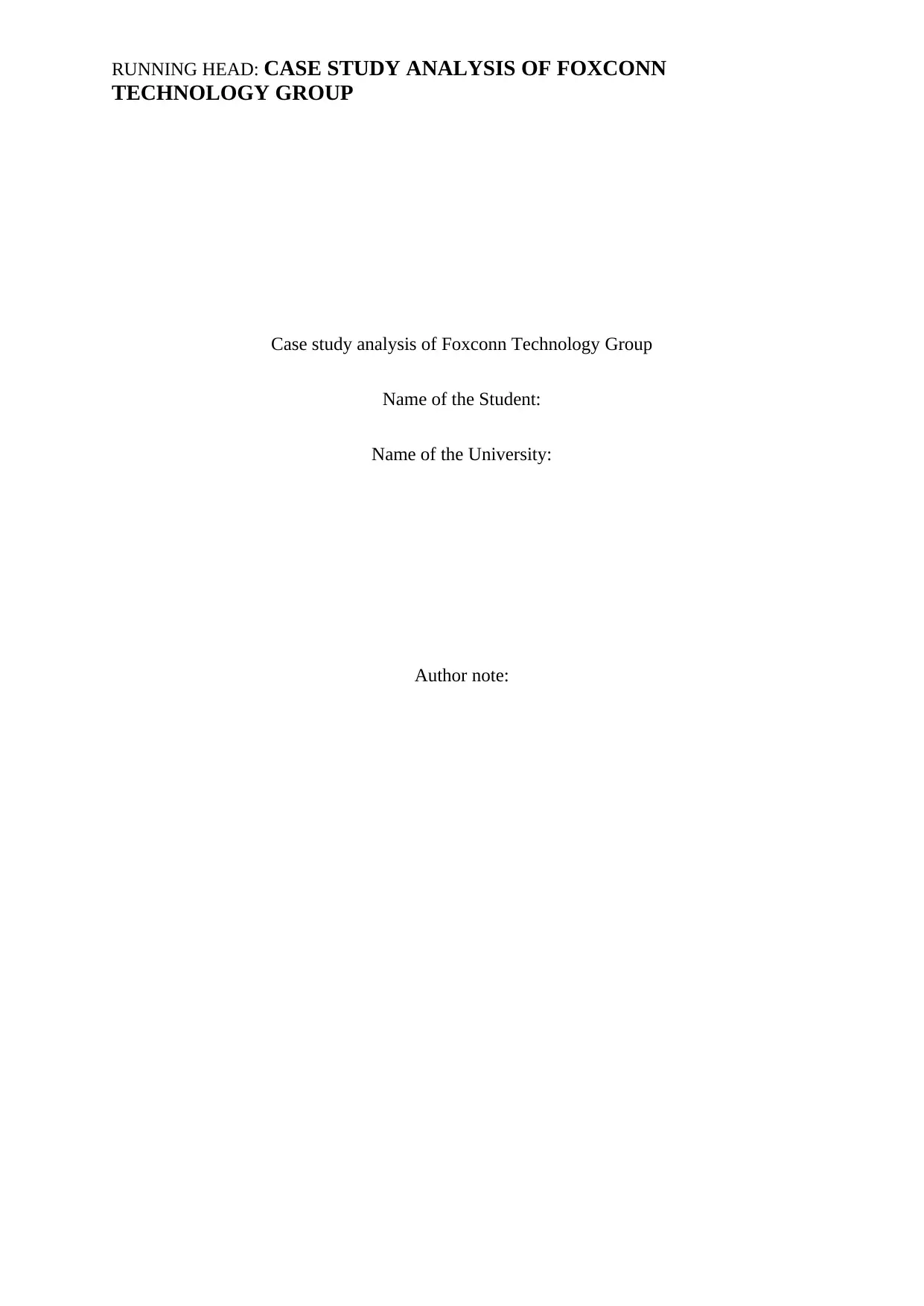
RUNNING HEAD: CASE STUDY ANALYSIS OF FOXCONN
TECHNOLOGY GROUP
Case study analysis of Foxconn Technology Group
Name of the Student:
Name of the University:
Author note:
TECHNOLOGY GROUP
Case study analysis of Foxconn Technology Group
Name of the Student:
Name of the University:
Author note:
Paraphrase This Document
Need a fresh take? Get an instant paraphrase of this document with our AI Paraphraser
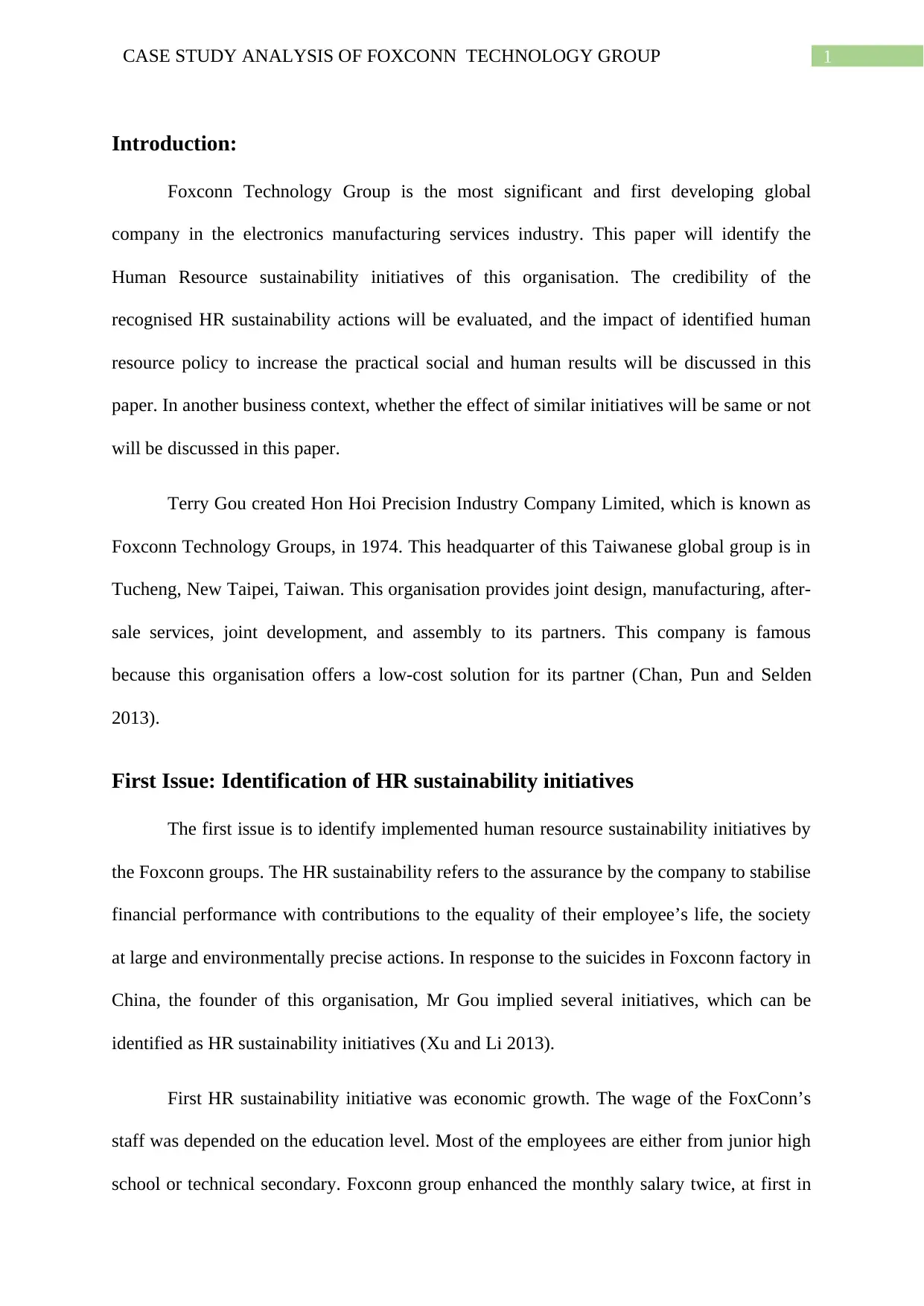
1CASE STUDY ANALYSIS OF FOXCONN TECHNOLOGY GROUP
Introduction:
Foxconn Technology Group is the most significant and first developing global
company in the electronics manufacturing services industry. This paper will identify the
Human Resource sustainability initiatives of this organisation. The credibility of the
recognised HR sustainability actions will be evaluated, and the impact of identified human
resource policy to increase the practical social and human results will be discussed in this
paper. In another business context, whether the effect of similar initiatives will be same or not
will be discussed in this paper.
Terry Gou created Hon Hoi Precision Industry Company Limited, which is known as
Foxconn Technology Groups, in 1974. This headquarter of this Taiwanese global group is in
Tucheng, New Taipei, Taiwan. This organisation provides joint design, manufacturing, after-
sale services, joint development, and assembly to its partners. This company is famous
because this organisation offers a low-cost solution for its partner (Chan, Pun and Selden
2013).
First Issue: Identification of HR sustainability initiatives
The first issue is to identify implemented human resource sustainability initiatives by
the Foxconn groups. The HR sustainability refers to the assurance by the company to stabilise
financial performance with contributions to the equality of their employee’s life, the society
at large and environmentally precise actions. In response to the suicides in Foxconn factory in
China, the founder of this organisation, Mr Gou implied several initiatives, which can be
identified as HR sustainability initiatives (Xu and Li 2013).
First HR sustainability initiative was economic growth. The wage of the FoxConn’s
staff was depended on the education level. Most of the employees are either from junior high
school or technical secondary. Foxconn group enhanced the monthly salary twice, at first in
Introduction:
Foxconn Technology Group is the most significant and first developing global
company in the electronics manufacturing services industry. This paper will identify the
Human Resource sustainability initiatives of this organisation. The credibility of the
recognised HR sustainability actions will be evaluated, and the impact of identified human
resource policy to increase the practical social and human results will be discussed in this
paper. In another business context, whether the effect of similar initiatives will be same or not
will be discussed in this paper.
Terry Gou created Hon Hoi Precision Industry Company Limited, which is known as
Foxconn Technology Groups, in 1974. This headquarter of this Taiwanese global group is in
Tucheng, New Taipei, Taiwan. This organisation provides joint design, manufacturing, after-
sale services, joint development, and assembly to its partners. This company is famous
because this organisation offers a low-cost solution for its partner (Chan, Pun and Selden
2013).
First Issue: Identification of HR sustainability initiatives
The first issue is to identify implemented human resource sustainability initiatives by
the Foxconn groups. The HR sustainability refers to the assurance by the company to stabilise
financial performance with contributions to the equality of their employee’s life, the society
at large and environmentally precise actions. In response to the suicides in Foxconn factory in
China, the founder of this organisation, Mr Gou implied several initiatives, which can be
identified as HR sustainability initiatives (Xu and Li 2013).
First HR sustainability initiative was economic growth. The wage of the FoxConn’s
staff was depended on the education level. Most of the employees are either from junior high
school or technical secondary. Foxconn group enhanced the monthly salary twice, at first in
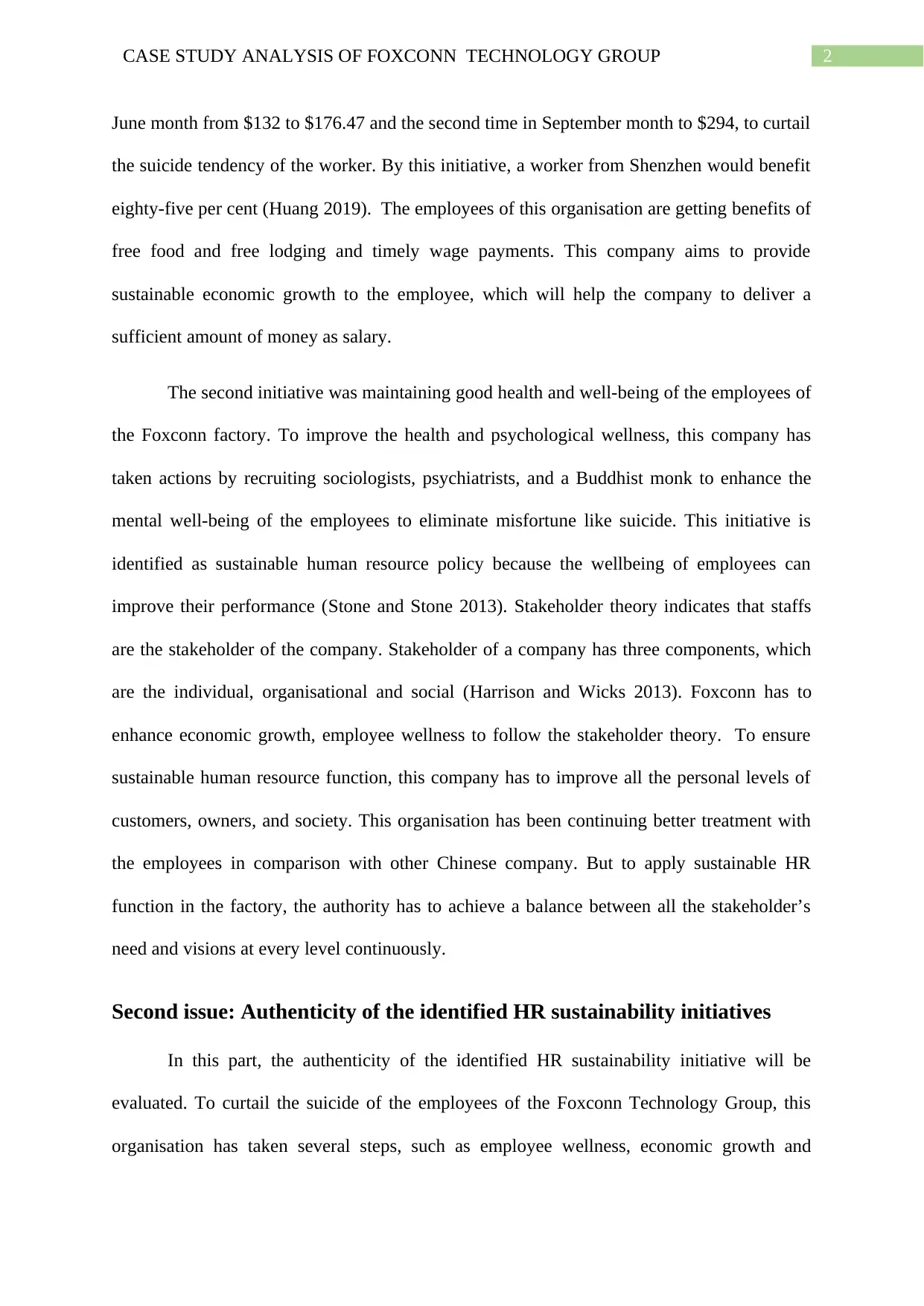
2CASE STUDY ANALYSIS OF FOXCONN TECHNOLOGY GROUP
June month from $132 to $176.47 and the second time in September month to $294, to curtail
the suicide tendency of the worker. By this initiative, a worker from Shenzhen would benefit
eighty-five per cent (Huang 2019). The employees of this organisation are getting benefits of
free food and free lodging and timely wage payments. This company aims to provide
sustainable economic growth to the employee, which will help the company to deliver a
sufficient amount of money as salary.
The second initiative was maintaining good health and well-being of the employees of
the Foxconn factory. To improve the health and psychological wellness, this company has
taken actions by recruiting sociologists, psychiatrists, and a Buddhist monk to enhance the
mental well-being of the employees to eliminate misfortune like suicide. This initiative is
identified as sustainable human resource policy because the wellbeing of employees can
improve their performance (Stone and Stone 2013). Stakeholder theory indicates that staffs
are the stakeholder of the company. Stakeholder of a company has three components, which
are the individual, organisational and social (Harrison and Wicks 2013). Foxconn has to
enhance economic growth, employee wellness to follow the stakeholder theory. To ensure
sustainable human resource function, this company has to improve all the personal levels of
customers, owners, and society. This organisation has been continuing better treatment with
the employees in comparison with other Chinese company. But to apply sustainable HR
function in the factory, the authority has to achieve a balance between all the stakeholder’s
need and visions at every level continuously.
Second issue: Authenticity of the identified HR sustainability initiatives
In this part, the authenticity of the identified HR sustainability initiative will be
evaluated. To curtail the suicide of the employees of the Foxconn Technology Group, this
organisation has taken several steps, such as employee wellness, economic growth and
June month from $132 to $176.47 and the second time in September month to $294, to curtail
the suicide tendency of the worker. By this initiative, a worker from Shenzhen would benefit
eighty-five per cent (Huang 2019). The employees of this organisation are getting benefits of
free food and free lodging and timely wage payments. This company aims to provide
sustainable economic growth to the employee, which will help the company to deliver a
sufficient amount of money as salary.
The second initiative was maintaining good health and well-being of the employees of
the Foxconn factory. To improve the health and psychological wellness, this company has
taken actions by recruiting sociologists, psychiatrists, and a Buddhist monk to enhance the
mental well-being of the employees to eliminate misfortune like suicide. This initiative is
identified as sustainable human resource policy because the wellbeing of employees can
improve their performance (Stone and Stone 2013). Stakeholder theory indicates that staffs
are the stakeholder of the company. Stakeholder of a company has three components, which
are the individual, organisational and social (Harrison and Wicks 2013). Foxconn has to
enhance economic growth, employee wellness to follow the stakeholder theory. To ensure
sustainable human resource function, this company has to improve all the personal levels of
customers, owners, and society. This organisation has been continuing better treatment with
the employees in comparison with other Chinese company. But to apply sustainable HR
function in the factory, the authority has to achieve a balance between all the stakeholder’s
need and visions at every level continuously.
Second issue: Authenticity of the identified HR sustainability initiatives
In this part, the authenticity of the identified HR sustainability initiative will be
evaluated. To curtail the suicide of the employees of the Foxconn Technology Group, this
organisation has taken several steps, such as employee wellness, economic growth and
⊘ This is a preview!⊘
Do you want full access?
Subscribe today to unlock all pages.

Trusted by 1+ million students worldwide
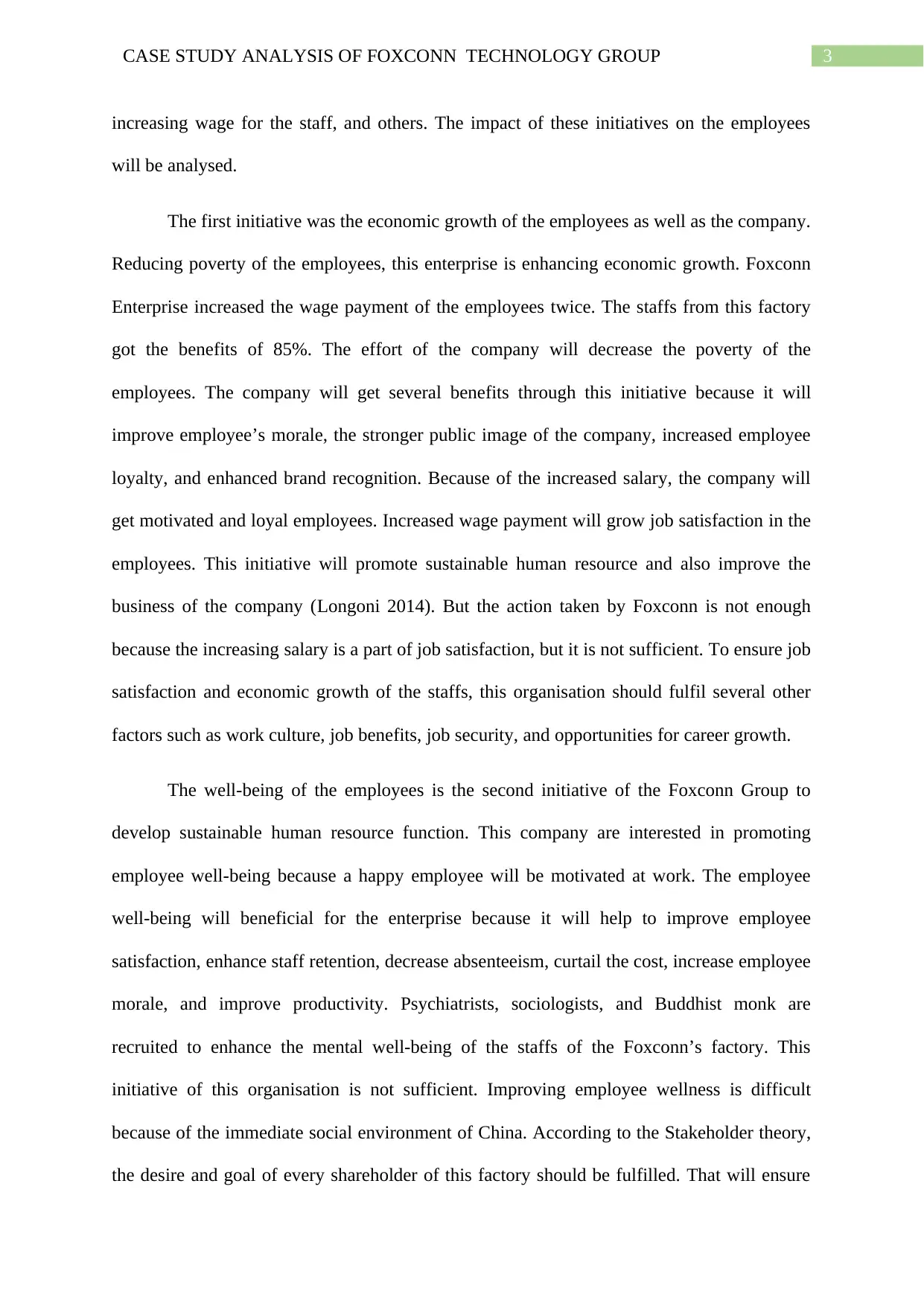
3CASE STUDY ANALYSIS OF FOXCONN TECHNOLOGY GROUP
increasing wage for the staff, and others. The impact of these initiatives on the employees
will be analysed.
The first initiative was the economic growth of the employees as well as the company.
Reducing poverty of the employees, this enterprise is enhancing economic growth. Foxconn
Enterprise increased the wage payment of the employees twice. The staffs from this factory
got the benefits of 85%. The effort of the company will decrease the poverty of the
employees. The company will get several benefits through this initiative because it will
improve employee’s morale, the stronger public image of the company, increased employee
loyalty, and enhanced brand recognition. Because of the increased salary, the company will
get motivated and loyal employees. Increased wage payment will grow job satisfaction in the
employees. This initiative will promote sustainable human resource and also improve the
business of the company (Longoni 2014). But the action taken by Foxconn is not enough
because the increasing salary is a part of job satisfaction, but it is not sufficient. To ensure job
satisfaction and economic growth of the staffs, this organisation should fulfil several other
factors such as work culture, job benefits, job security, and opportunities for career growth.
The well-being of the employees is the second initiative of the Foxconn Group to
develop sustainable human resource function. This company are interested in promoting
employee well-being because a happy employee will be motivated at work. The employee
well-being will beneficial for the enterprise because it will help to improve employee
satisfaction, enhance staff retention, decrease absenteeism, curtail the cost, increase employee
morale, and improve productivity. Psychiatrists, sociologists, and Buddhist monk are
recruited to enhance the mental well-being of the staffs of the Foxconn’s factory. This
initiative of this organisation is not sufficient. Improving employee wellness is difficult
because of the immediate social environment of China. According to the Stakeholder theory,
the desire and goal of every shareholder of this factory should be fulfilled. That will ensure
increasing wage for the staff, and others. The impact of these initiatives on the employees
will be analysed.
The first initiative was the economic growth of the employees as well as the company.
Reducing poverty of the employees, this enterprise is enhancing economic growth. Foxconn
Enterprise increased the wage payment of the employees twice. The staffs from this factory
got the benefits of 85%. The effort of the company will decrease the poverty of the
employees. The company will get several benefits through this initiative because it will
improve employee’s morale, the stronger public image of the company, increased employee
loyalty, and enhanced brand recognition. Because of the increased salary, the company will
get motivated and loyal employees. Increased wage payment will grow job satisfaction in the
employees. This initiative will promote sustainable human resource and also improve the
business of the company (Longoni 2014). But the action taken by Foxconn is not enough
because the increasing salary is a part of job satisfaction, but it is not sufficient. To ensure job
satisfaction and economic growth of the staffs, this organisation should fulfil several other
factors such as work culture, job benefits, job security, and opportunities for career growth.
The well-being of the employees is the second initiative of the Foxconn Group to
develop sustainable human resource function. This company are interested in promoting
employee well-being because a happy employee will be motivated at work. The employee
well-being will beneficial for the enterprise because it will help to improve employee
satisfaction, enhance staff retention, decrease absenteeism, curtail the cost, increase employee
morale, and improve productivity. Psychiatrists, sociologists, and Buddhist monk are
recruited to enhance the mental well-being of the staffs of the Foxconn’s factory. This
initiative of this organisation is not sufficient. Improving employee wellness is difficult
because of the immediate social environment of China. According to the Stakeholder theory,
the desire and goal of every shareholder of this factory should be fulfilled. That will ensure
Paraphrase This Document
Need a fresh take? Get an instant paraphrase of this document with our AI Paraphraser
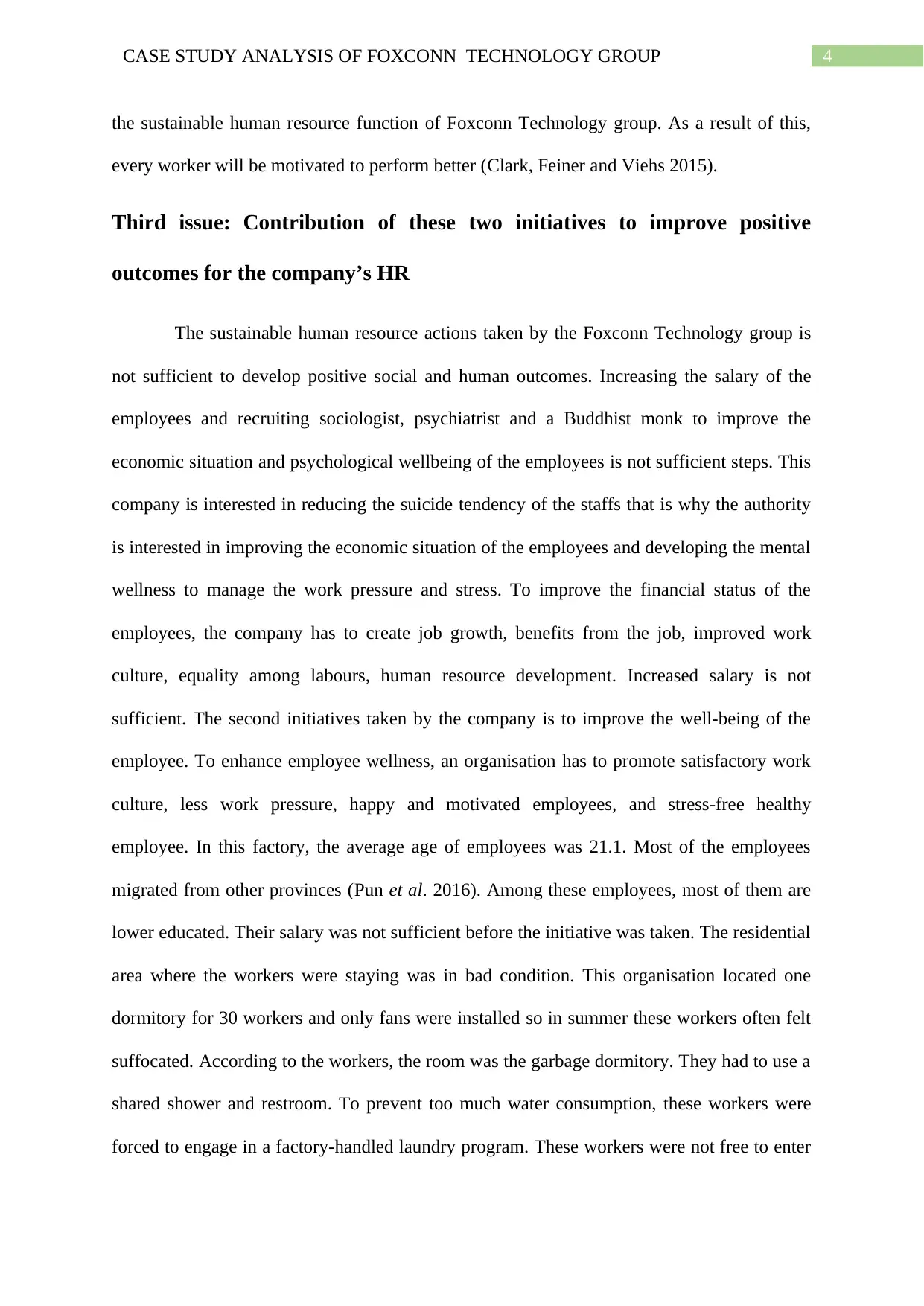
4CASE STUDY ANALYSIS OF FOXCONN TECHNOLOGY GROUP
the sustainable human resource function of Foxconn Technology group. As a result of this,
every worker will be motivated to perform better (Clark, Feiner and Viehs 2015).
Third issue: Contribution of these two initiatives to improve positive
outcomes for the company’s HR
The sustainable human resource actions taken by the Foxconn Technology group is
not sufficient to develop positive social and human outcomes. Increasing the salary of the
employees and recruiting sociologist, psychiatrist and a Buddhist monk to improve the
economic situation and psychological wellbeing of the employees is not sufficient steps. This
company is interested in reducing the suicide tendency of the staffs that is why the authority
is interested in improving the economic situation of the employees and developing the mental
wellness to manage the work pressure and stress. To improve the financial status of the
employees, the company has to create job growth, benefits from the job, improved work
culture, equality among labours, human resource development. Increased salary is not
sufficient. The second initiatives taken by the company is to improve the well-being of the
employee. To enhance employee wellness, an organisation has to promote satisfactory work
culture, less work pressure, happy and motivated employees, and stress-free healthy
employee. In this factory, the average age of employees was 21.1. Most of the employees
migrated from other provinces (Pun et al. 2016). Among these employees, most of them are
lower educated. Their salary was not sufficient before the initiative was taken. The residential
area where the workers were staying was in bad condition. This organisation located one
dormitory for 30 workers and only fans were installed so in summer these workers often felt
suffocated. According to the workers, the room was the garbage dormitory. They had to use a
shared shower and restroom. To prevent too much water consumption, these workers were
forced to engage in a factory-handled laundry program. These workers were not free to enter
the sustainable human resource function of Foxconn Technology group. As a result of this,
every worker will be motivated to perform better (Clark, Feiner and Viehs 2015).
Third issue: Contribution of these two initiatives to improve positive
outcomes for the company’s HR
The sustainable human resource actions taken by the Foxconn Technology group is
not sufficient to develop positive social and human outcomes. Increasing the salary of the
employees and recruiting sociologist, psychiatrist and a Buddhist monk to improve the
economic situation and psychological wellbeing of the employees is not sufficient steps. This
company is interested in reducing the suicide tendency of the staffs that is why the authority
is interested in improving the economic situation of the employees and developing the mental
wellness to manage the work pressure and stress. To improve the financial status of the
employees, the company has to create job growth, benefits from the job, improved work
culture, equality among labours, human resource development. Increased salary is not
sufficient. The second initiatives taken by the company is to improve the well-being of the
employee. To enhance employee wellness, an organisation has to promote satisfactory work
culture, less work pressure, happy and motivated employees, and stress-free healthy
employee. In this factory, the average age of employees was 21.1. Most of the employees
migrated from other provinces (Pun et al. 2016). Among these employees, most of them are
lower educated. Their salary was not sufficient before the initiative was taken. The residential
area where the workers were staying was in bad condition. This organisation located one
dormitory for 30 workers and only fans were installed so in summer these workers often felt
suffocated. According to the workers, the room was the garbage dormitory. They had to use a
shared shower and restroom. To prevent too much water consumption, these workers were
forced to engage in a factory-handled laundry program. These workers were not free to enter
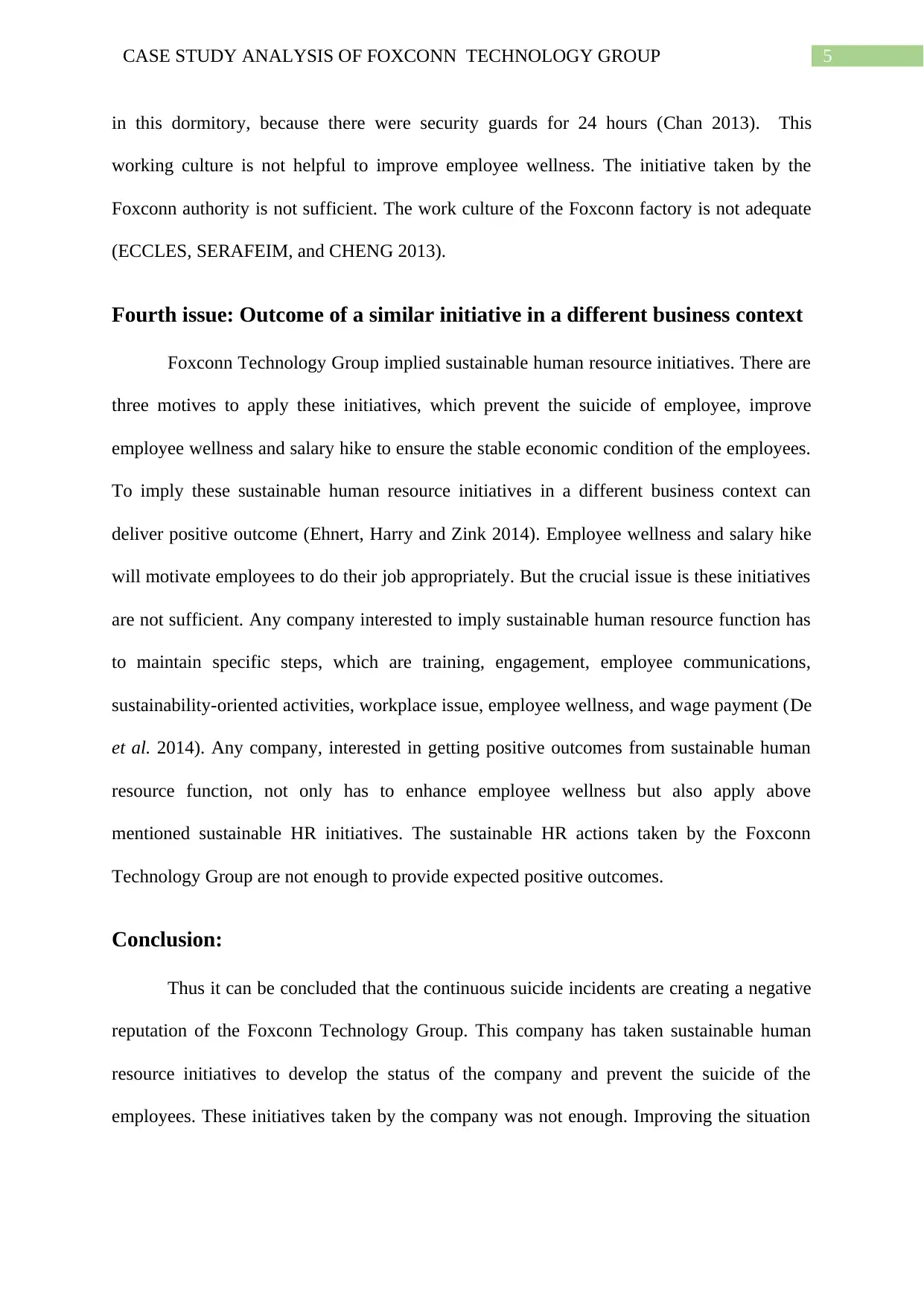
5CASE STUDY ANALYSIS OF FOXCONN TECHNOLOGY GROUP
in this dormitory, because there were security guards for 24 hours (Chan 2013). This
working culture is not helpful to improve employee wellness. The initiative taken by the
Foxconn authority is not sufficient. The work culture of the Foxconn factory is not adequate
(ECCLES, SERAFEIM, and CHENG 2013).
Fourth issue: Outcome of a similar initiative in a different business context
Foxconn Technology Group implied sustainable human resource initiatives. There are
three motives to apply these initiatives, which prevent the suicide of employee, improve
employee wellness and salary hike to ensure the stable economic condition of the employees.
To imply these sustainable human resource initiatives in a different business context can
deliver positive outcome (Ehnert, Harry and Zink 2014). Employee wellness and salary hike
will motivate employees to do their job appropriately. But the crucial issue is these initiatives
are not sufficient. Any company interested to imply sustainable human resource function has
to maintain specific steps, which are training, engagement, employee communications,
sustainability-oriented activities, workplace issue, employee wellness, and wage payment (De
et al. 2014). Any company, interested in getting positive outcomes from sustainable human
resource function, not only has to enhance employee wellness but also apply above
mentioned sustainable HR initiatives. The sustainable HR actions taken by the Foxconn
Technology Group are not enough to provide expected positive outcomes.
Conclusion:
Thus it can be concluded that the continuous suicide incidents are creating a negative
reputation of the Foxconn Technology Group. This company has taken sustainable human
resource initiatives to develop the status of the company and prevent the suicide of the
employees. These initiatives taken by the company was not enough. Improving the situation
in this dormitory, because there were security guards for 24 hours (Chan 2013). This
working culture is not helpful to improve employee wellness. The initiative taken by the
Foxconn authority is not sufficient. The work culture of the Foxconn factory is not adequate
(ECCLES, SERAFEIM, and CHENG 2013).
Fourth issue: Outcome of a similar initiative in a different business context
Foxconn Technology Group implied sustainable human resource initiatives. There are
three motives to apply these initiatives, which prevent the suicide of employee, improve
employee wellness and salary hike to ensure the stable economic condition of the employees.
To imply these sustainable human resource initiatives in a different business context can
deliver positive outcome (Ehnert, Harry and Zink 2014). Employee wellness and salary hike
will motivate employees to do their job appropriately. But the crucial issue is these initiatives
are not sufficient. Any company interested to imply sustainable human resource function has
to maintain specific steps, which are training, engagement, employee communications,
sustainability-oriented activities, workplace issue, employee wellness, and wage payment (De
et al. 2014). Any company, interested in getting positive outcomes from sustainable human
resource function, not only has to enhance employee wellness but also apply above
mentioned sustainable HR initiatives. The sustainable HR actions taken by the Foxconn
Technology Group are not enough to provide expected positive outcomes.
Conclusion:
Thus it can be concluded that the continuous suicide incidents are creating a negative
reputation of the Foxconn Technology Group. This company has taken sustainable human
resource initiatives to develop the status of the company and prevent the suicide of the
employees. These initiatives taken by the company was not enough. Improving the situation
⊘ This is a preview!⊘
Do you want full access?
Subscribe today to unlock all pages.

Trusted by 1+ million students worldwide
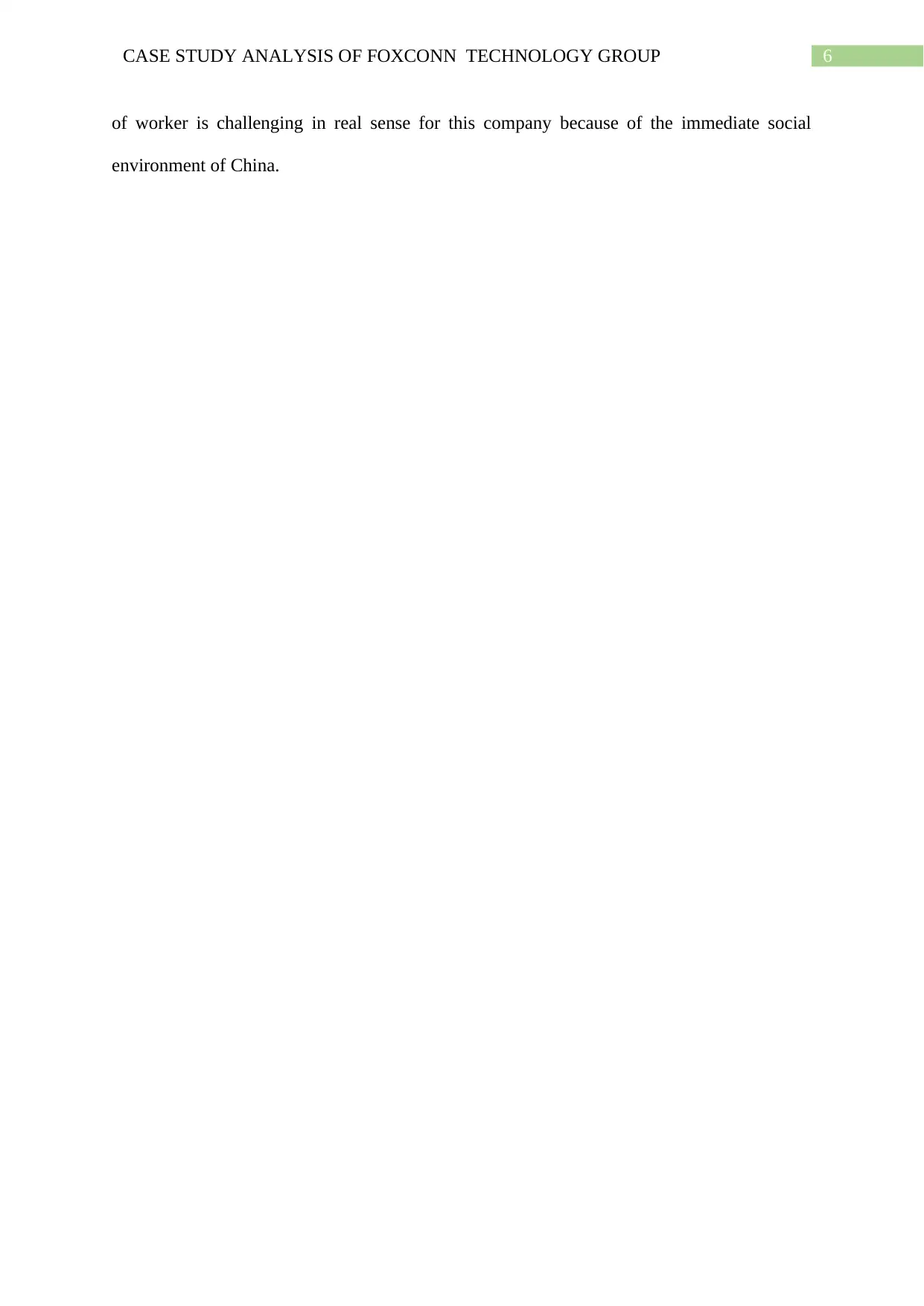
6CASE STUDY ANALYSIS OF FOXCONN TECHNOLOGY GROUP
of worker is challenging in real sense for this company because of the immediate social
environment of China.
of worker is challenging in real sense for this company because of the immediate social
environment of China.
Paraphrase This Document
Need a fresh take? Get an instant paraphrase of this document with our AI Paraphraser
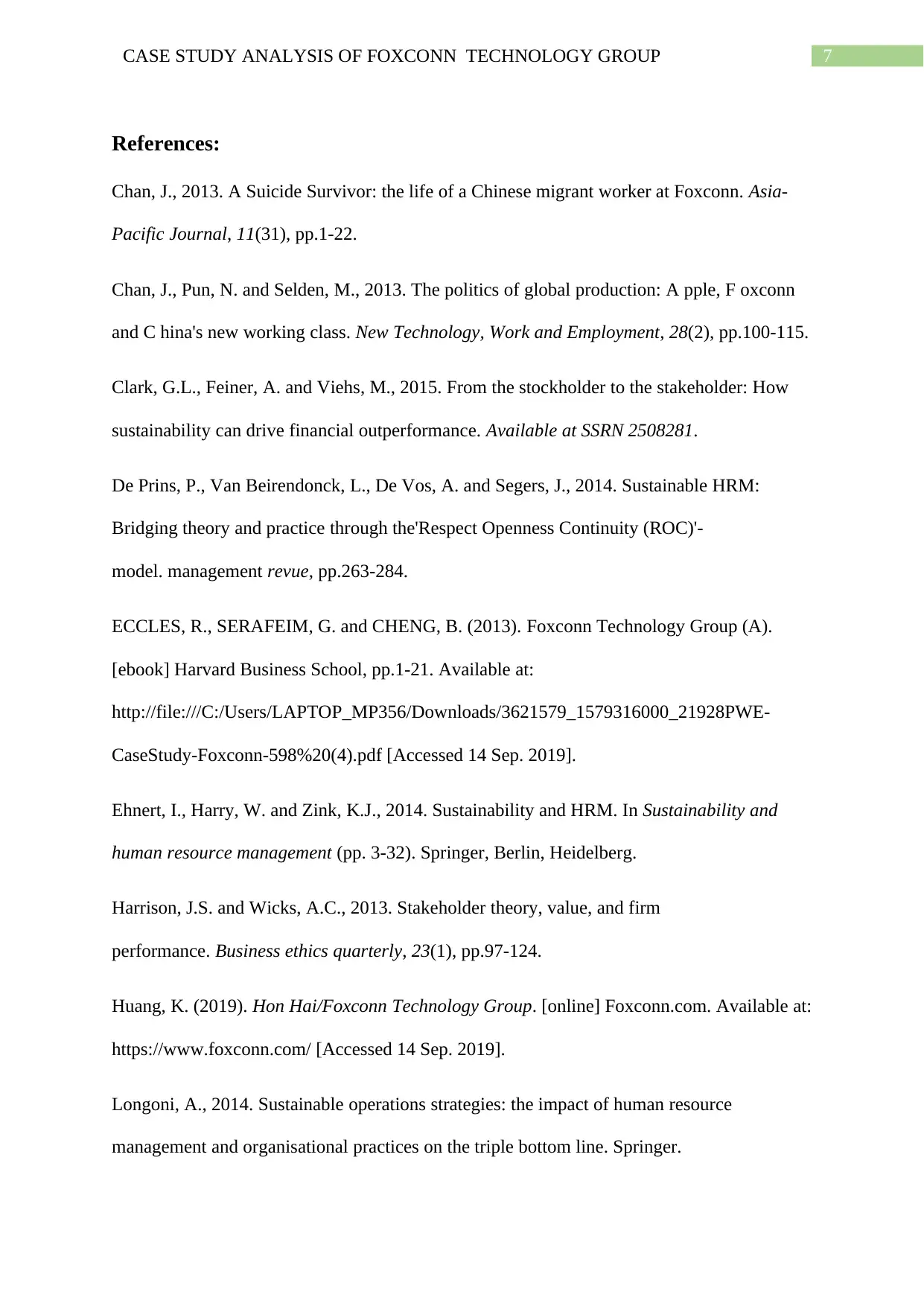
7CASE STUDY ANALYSIS OF FOXCONN TECHNOLOGY GROUP
References:
Chan, J., 2013. A Suicide Survivor: the life of a Chinese migrant worker at Foxconn. Asia-
Pacific Journal, 11(31), pp.1-22.
Chan, J., Pun, N. and Selden, M., 2013. The politics of global production: A pple, F oxconn
and C hina's new working class. New Technology, Work and Employment, 28(2), pp.100-115.
Clark, G.L., Feiner, A. and Viehs, M., 2015. From the stockholder to the stakeholder: How
sustainability can drive financial outperformance. Available at SSRN 2508281.
De Prins, P., Van Beirendonck, L., De Vos, A. and Segers, J., 2014. Sustainable HRM:
Bridging theory and practice through the'Respect Openness Continuity (ROC)'-
model. management revue, pp.263-284.
ECCLES, R., SERAFEIM, G. and CHENG, B. (2013). Foxconn Technology Group (A).
[ebook] Harvard Business School, pp.1-21. Available at:
http://file:///C:/Users/LAPTOP_MP356/Downloads/3621579_1579316000_21928PWE-
CaseStudy-Foxconn-598%20(4).pdf [Accessed 14 Sep. 2019].
Ehnert, I., Harry, W. and Zink, K.J., 2014. Sustainability and HRM. In Sustainability and
human resource management (pp. 3-32). Springer, Berlin, Heidelberg.
Harrison, J.S. and Wicks, A.C., 2013. Stakeholder theory, value, and firm
performance. Business ethics quarterly, 23(1), pp.97-124.
Huang, K. (2019). Hon Hai/Foxconn Technology Group. [online] Foxconn.com. Available at:
https://www.foxconn.com/ [Accessed 14 Sep. 2019].
Longoni, A., 2014. Sustainable operations strategies: the impact of human resource
management and organisational practices on the triple bottom line. Springer.
References:
Chan, J., 2013. A Suicide Survivor: the life of a Chinese migrant worker at Foxconn. Asia-
Pacific Journal, 11(31), pp.1-22.
Chan, J., Pun, N. and Selden, M., 2013. The politics of global production: A pple, F oxconn
and C hina's new working class. New Technology, Work and Employment, 28(2), pp.100-115.
Clark, G.L., Feiner, A. and Viehs, M., 2015. From the stockholder to the stakeholder: How
sustainability can drive financial outperformance. Available at SSRN 2508281.
De Prins, P., Van Beirendonck, L., De Vos, A. and Segers, J., 2014. Sustainable HRM:
Bridging theory and practice through the'Respect Openness Continuity (ROC)'-
model. management revue, pp.263-284.
ECCLES, R., SERAFEIM, G. and CHENG, B. (2013). Foxconn Technology Group (A).
[ebook] Harvard Business School, pp.1-21. Available at:
http://file:///C:/Users/LAPTOP_MP356/Downloads/3621579_1579316000_21928PWE-
CaseStudy-Foxconn-598%20(4).pdf [Accessed 14 Sep. 2019].
Ehnert, I., Harry, W. and Zink, K.J., 2014. Sustainability and HRM. In Sustainability and
human resource management (pp. 3-32). Springer, Berlin, Heidelberg.
Harrison, J.S. and Wicks, A.C., 2013. Stakeholder theory, value, and firm
performance. Business ethics quarterly, 23(1), pp.97-124.
Huang, K. (2019). Hon Hai/Foxconn Technology Group. [online] Foxconn.com. Available at:
https://www.foxconn.com/ [Accessed 14 Sep. 2019].
Longoni, A., 2014. Sustainable operations strategies: the impact of human resource
management and organisational practices on the triple bottom line. Springer.
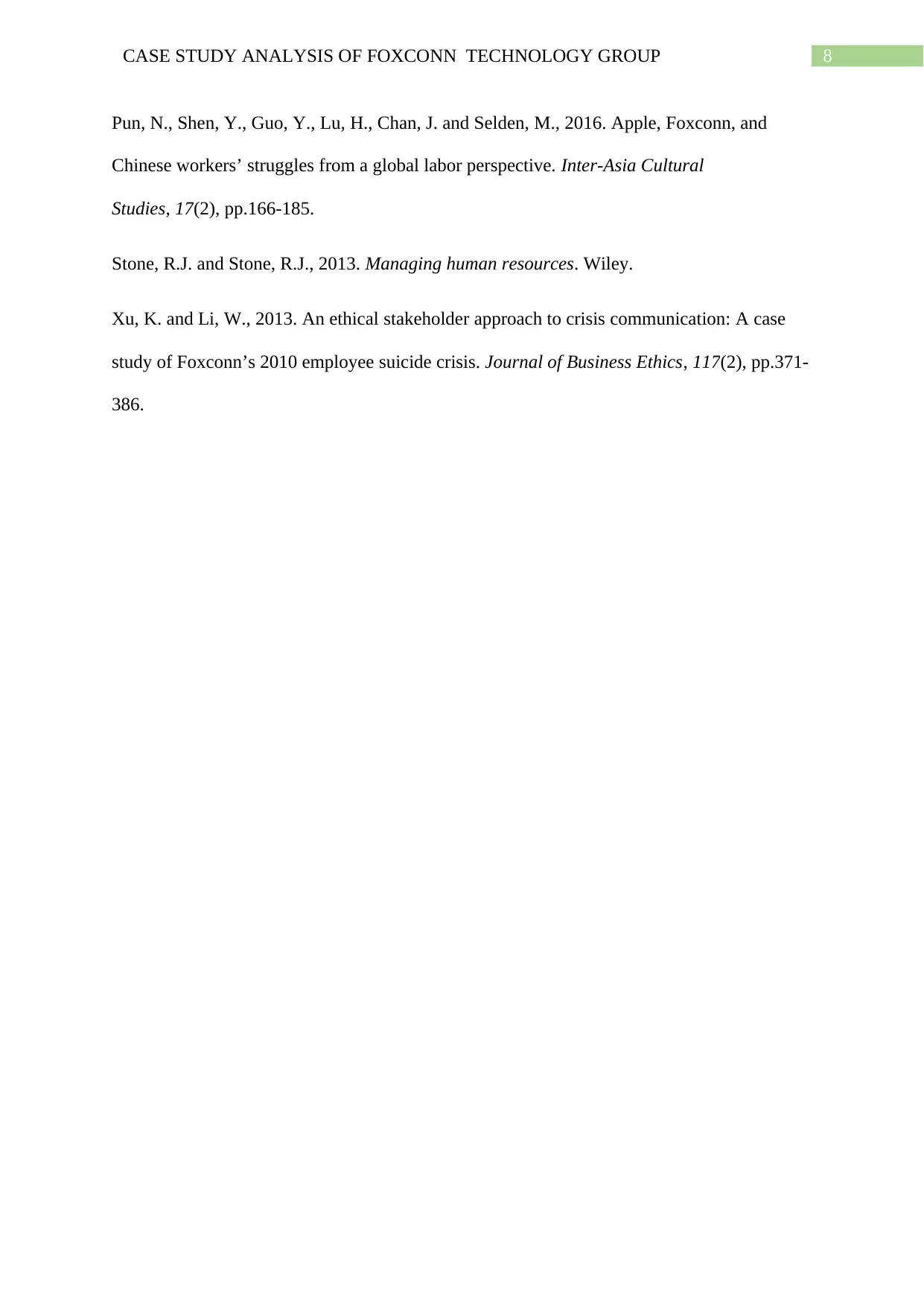
8CASE STUDY ANALYSIS OF FOXCONN TECHNOLOGY GROUP
Pun, N., Shen, Y., Guo, Y., Lu, H., Chan, J. and Selden, M., 2016. Apple, Foxconn, and
Chinese workers’ struggles from a global labor perspective. Inter-Asia Cultural
Studies, 17(2), pp.166-185.
Stone, R.J. and Stone, R.J., 2013. Managing human resources. Wiley.
Xu, K. and Li, W., 2013. An ethical stakeholder approach to crisis communication: A case
study of Foxconn’s 2010 employee suicide crisis. Journal of Business Ethics, 117(2), pp.371-
386.
Pun, N., Shen, Y., Guo, Y., Lu, H., Chan, J. and Selden, M., 2016. Apple, Foxconn, and
Chinese workers’ struggles from a global labor perspective. Inter-Asia Cultural
Studies, 17(2), pp.166-185.
Stone, R.J. and Stone, R.J., 2013. Managing human resources. Wiley.
Xu, K. and Li, W., 2013. An ethical stakeholder approach to crisis communication: A case
study of Foxconn’s 2010 employee suicide crisis. Journal of Business Ethics, 117(2), pp.371-
386.
⊘ This is a preview!⊘
Do you want full access?
Subscribe today to unlock all pages.

Trusted by 1+ million students worldwide
1 out of 9
Related Documents
Your All-in-One AI-Powered Toolkit for Academic Success.
+13062052269
info@desklib.com
Available 24*7 on WhatsApp / Email
![[object Object]](/_next/static/media/star-bottom.7253800d.svg)
Unlock your academic potential
Copyright © 2020–2025 A2Z Services. All Rights Reserved. Developed and managed by ZUCOL.




